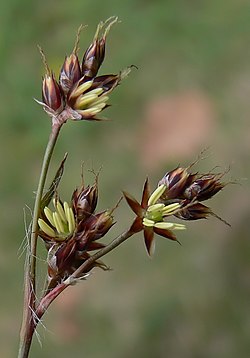| Luzula campestris | |
|---|---|
 | |
| Scientific classification | |
| Kingdom: | Plantae |
| Clade: | Tracheophytes |
| Clade: | Angiosperms |
| Clade: | Monocots |
| Clade: | Commelinids |
| Order: | Poales |
| Family: | Juncaceae |
| Genus: | Luzula |
| Species: | L. campestris |
| Binomial name | |
| Luzula campestris | |
| Synonyms | |
Juncus campestrisL. | |
Luzula campestris, commonly known as field wood-rush or Good Friday grass is a flowering plant in the rush family Juncaceae. [1] It is also one of the plants known as chimney sweeps [2] or sweep's broom [3] because of the brush-like appearance of their flowers. [4] This is a very common plant throughout temperate Europe extending to the Caucasus. This species of Luzula is found on all types of native grasslands, and cultivated areas such as lawns, golf-course greens and fields.

